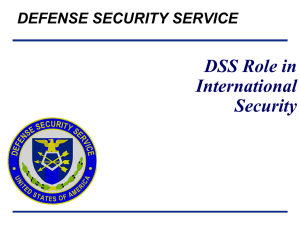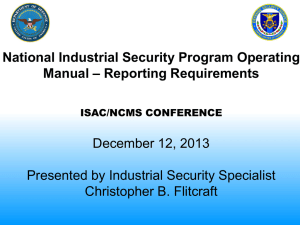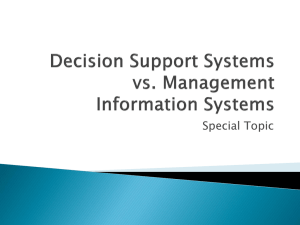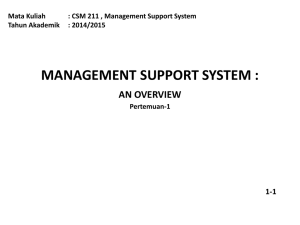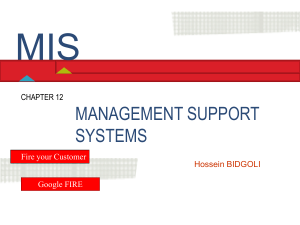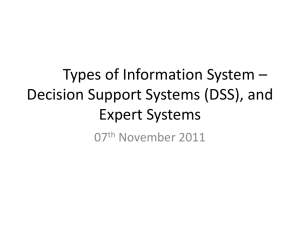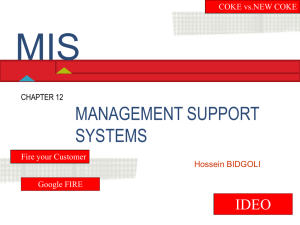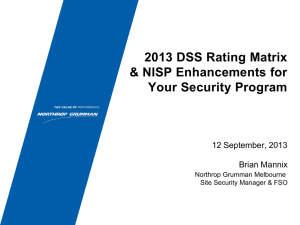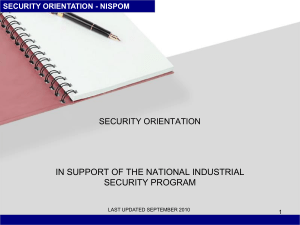Data Spill - Florida Industrial Security Working Group
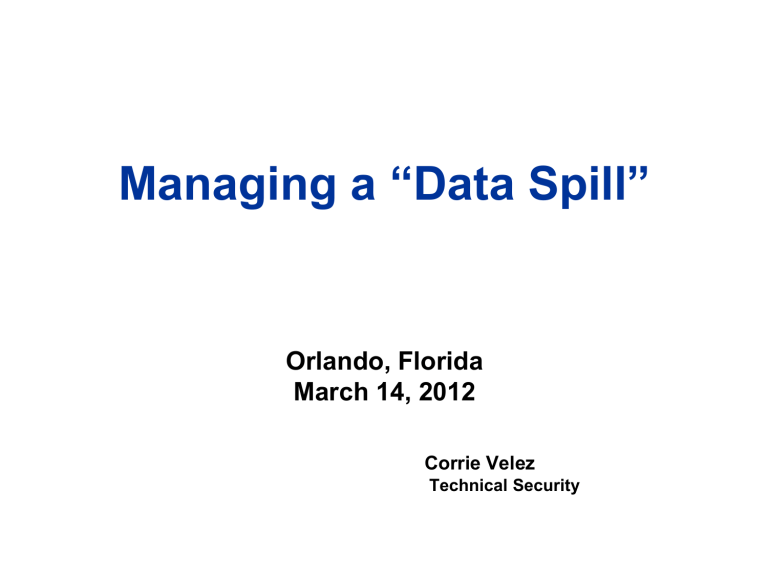
Managing a “Data Spill”
Orlando, Florida
March 14, 2012
Corrie Velez
Technical Security
Objectives
• Classified Data Spill
• Data Spill / Incident Plan
• Responsibilities
• Reporting
• Review steps for conducting an
Administrative Inquiry
• Review reporting requirements
• Discuss cleanup considerations
• Summary
Classified Data Spill
• AKA- Contamination or Classified Message
Incident
– Occurs when Classified Data is introduced to an Unclassified System or to a system accredited as a lower level classification than the data
SECRET
Unclassified
Classified Spill Definition
Classified Spills (also known as contaminations or classified message incidents) occur when classified data is introduced to an unclassified computer system or to a system accredited at a lower classification than the data.
Any classified spill will involve an Administrative Inquiry for the facility concerned.
(reference ISFO rev 3 section 5.2.3.1
)
SECRET
Data Spill / Incident Response Plan
• Provides a roadmap
• Defines structure, response and capability
• Meets unique organizational requirements
• Defines incidents, resources and support
• Supporting document that can be preapproved by Data Owners/Customers.
Reference ISFO Process Manual, Rev 3 2011.1, 5.2.3.1.1
Contamination occurs when…
• People not following the rules
• Confusion – didn’t understand
• Data not reviewed by SME IAW
SCG
• Received data electronically
(email or optical media) from outside source.
Responsibilities
• All Personnel
– Immediately open lines of communication
– Participate and support response efforts
– Assess risk / follow data owner (customer) guidelines and/or approved procedures
– Assign cleared people to assist cleanup
Responsibilities…cont
• FSO
– Acts as incident lead, notifies Government agencies, data and cleaning procedure, Id
Sender/Receiver(s) then coordinates the cleanup effort
Responsibilities…cont
• ISSM / ISSO
– Assess extent of spill and plans cleanup actions
– Contact GCA to receive their spill clean up procedure(s) or receive approval if forwarding the
DSS/Contractors’ procedure(s).
– Conducts cleanup actions
– Reports findings
– Protect/Isolate systems from further contamination, etc
Conduct a preliminary inquiry!
• Conduct immediately
What happened?
• Determine Who, What,
Where, Why and How
• “Did a loss, compromise or suspected compromise occur?”
NISPOM Para 1-303a
Sample preliminary inquiry
Timeline for
Initial Report
Top Secret : within 24-hours (1-day)
Secret / Confidential : within 72-hours (3-days)
Reporting Must be accomplished
• Guidance is located in:
– ISFO Process Manual Rev. 3 2011.1, pgs 96-98
– http://www.dss.mil/documents/cdse/ai-job-aid-forindustry.pdf
– DoD 5220.22-M, NISPOM Operating Manual
1-303. Reports of Loss, Compromise, or Suspected
Compromise.
Is there a loss, compromise, or suspected compromise?
• Loss: material can’t be located within a reasonable period of time
• Compromise: disclosure to unauthorized person(s)
• Suspected compromise: when disclosure can’t be reasonably precluded
Where to begin?
• Assemble team
• Physically isolate, protect all contaminated equipment
• Remove access from unauthorized personnel
What should be done? (cont.)
• Call your Defense Security Service (DSS) IS
Rep and/or ISSP*
• Contact your customer, the data owner
“Would you take care of this for me!”
DO NOT delete the suspect data yet!
* Information Systems Security Professional
What to expect from DSS
• Help you limit further systems from being contaminated.
• Work with you on sanitizing all infected systems.
Some important facts to consider…
• What platforms and O/Ss are involved?
• Are there any remote dial-ins
• Are there any other network connections?
• At what locations was the file or e-mail received (e-mail servers) or placed?
• Was the data encrypted?
• Was the file deleted?
• Is there RAID technology involved?
– ISFO Process Manual Rev. 3 2011.1 contains step-by-step descriptions starting on pg 100…to order the manual, go to: http://www.dss.mil/isp/odaa/request.html
ISFO Cleansing Checklists
• Inside of ISFO
(General, Desktop, Bl ackBerry devices and
Email Servers)
• Some Data Owners / customers may provide specific guidance / checklists to be used
What about an email server?
• What type of email system is involved?
• Is System Admin cleared?
• Is Tape/Disk Backup Admin cleared?
• Ensure areas where deleted files are retained are addressed, e.g., MS
Exchange’s deleted item recovery container).
MS Exchange is discussed because of its widespread use. DSS does not endorse the use of any products.
Forget any components?
Follow through!
• Gather and review
Audit Trails that are applicable
– Paper
– Electronic
• Interview all people known to be involved
Note …Do Not use email to communicate the “Who,
What, When, Where, Why, How” except for reporting requirements to DSS/Customer or others involved, (i.e. other contractors)
Prepare Final Report
• Write and submit the final report (Paragraph
1-303c, NISPOM)
• Due within 15 days of notification of spill
Sample Administrative Inquiry
Final Actions
• Request they provide additional cleanup steps within 30 days
• Send details to government customer to include cleanup action
• Include hardware and operating system platforms
“Create your data spill / incident plan prior to experiencing a data spill, for if you fail to plan, your plan will fail!”
~ Anonymous ISSM
Follow available guidance!
• NISPOM Admin Inquiry (AI) Report
Requirements (Paragraph 1-303)
– http://www.dss.mil/documents/odaa/nisp om2006-5220.pdf
• DSS Guidance for Conducting an AI
– http://www.dss.mil/documents/cdse/aijob-aid-for-industry.pdf
• Clearing and Sanitization Matrix
– ISFO Process Manual Rev. 3 2011.1 (to order the manual, go to: http://www.dss.mil/isp/odaa/request.html)
Overwrite utilities programs
• Determine types of devices and operating systems involved.
• Locate (acquire) approved overwrite utilities to sanitize the suspect data from systems
– Contact your DSS ISSP or the Data Owner if you require additional information on how to sanitize the affected media.
Administrative Inquiry (AI) Guidelines for Information Systems (IS) https://enrol.dss.mil/courseware/is201docs/AI_Guide_Nonaccredited_IS.pdf
Overwrite utilities:
• NIST Common Criteria (Sensitive Data Protection)
• Sun’s “Purge” ( Part of the O/S)
• SGI “FX” (Part of the O/S)
• Unishred Pro 3.3.1 (EAL1)
• BCWipe Total WipeOut
• Terminus 6
• White Canyon Wipe Drive (EAL4)
Note: This is a partial list of products that have enabled contamination cleanup in the past. DSS does not endorse any products.
Report suspenses!
• Timeline for Initial Report
– Top Secret : within 24-hours (1-day)
– Secret / Confidential : within 72-hours
(3-days)
• Timeline for Final Report
– Top Secret/Secret/Confidential: within
15-days of discovery
Administrative Inquiry (AI) Process Job Aid, dated Jul 2011
Summary
• What causes contaminations
• Possible cleanup considerations
• Reporting requirements
NISPOM Para 8-103b,c
